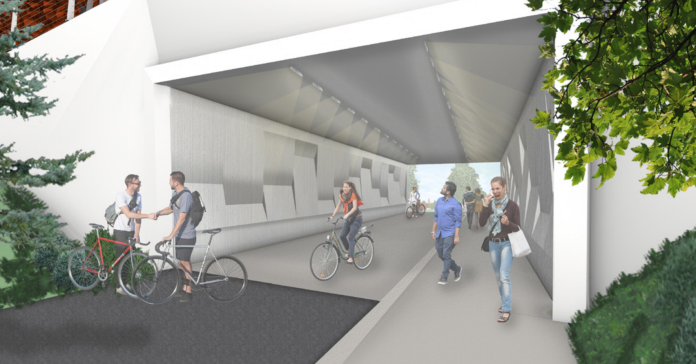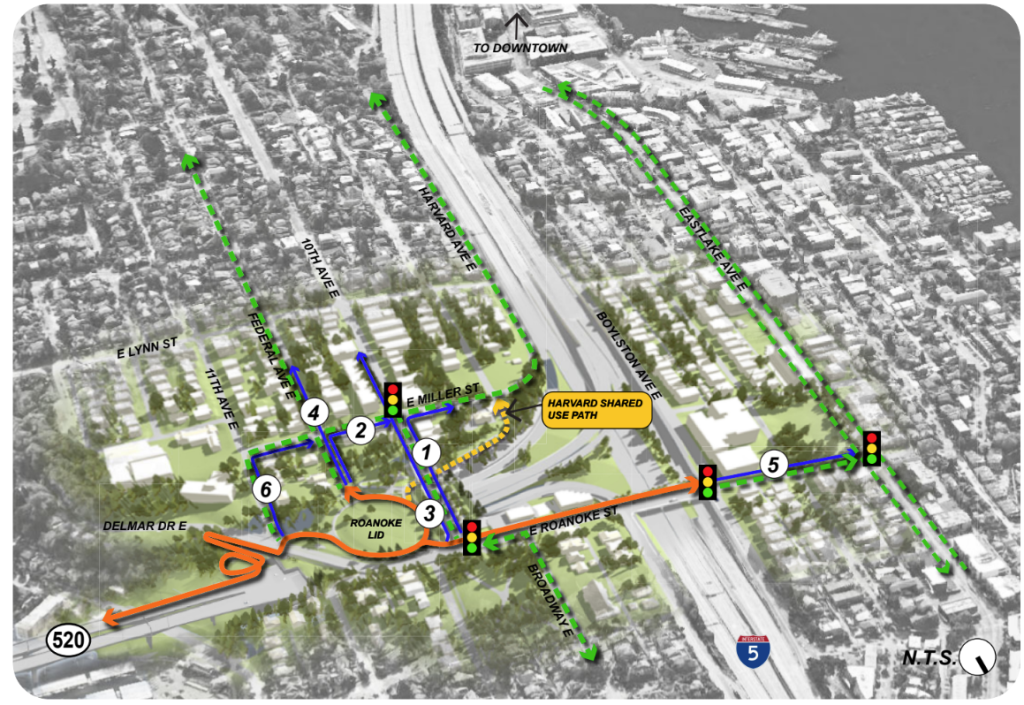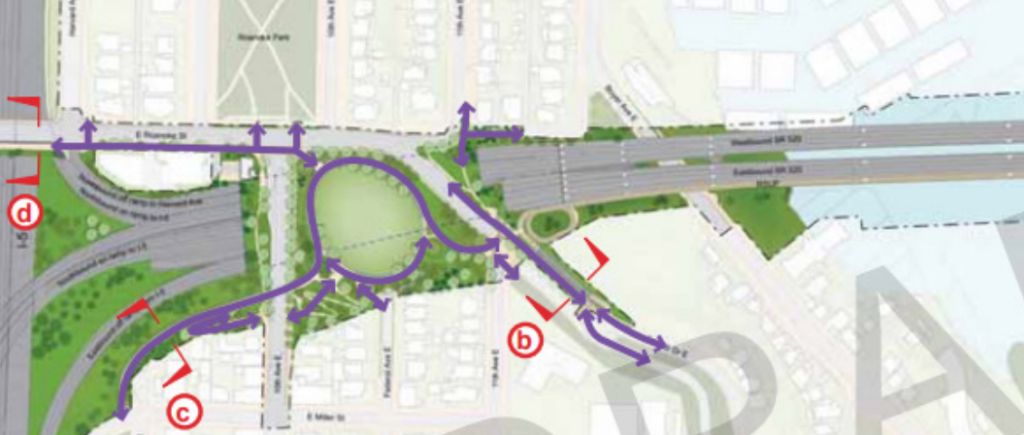
WSDOT is scrapping the planned SR 520 bike and pedestrian tunnel, forcing people who travel outside cars into dangerous territory.
As construction on SR 520 continues, the Washington State Department of Transportation (WSDOT) is cutting costs at the direction of the state legislature. The first casualty: a previously designed, hard-won bike and pedestrian thoroughfare known as the Harvard Connection, which links the new lid park and SR 520 trail to a popular bike route on Harvard Avenue. The trail and tunnel would create a safe, comfortable, and accessible multimodal transportation connection.
Unfortunately, WSDOT plans to cut this transportation equity lifeline from the project and abandon people who walk, bike, and roll – all so that they can save taxpayers a mere 2% of the budget shortfall. We cannot allow this to be the final word. WSDOT needs to find ways to save money without eliminating this essential element of the project.
Send a letter to the state legislators and WSDOT urging them to keep the Harvard Connection. More than 2,000 people have already contacted their legislators via this campaign, sponsored by Seattle Neighborhood Greenways in partnership with Disability Rights Washington.
The tunnel would link North Capitol Hill to the SR 520 multi-use trail, which originates in Redmond and passes through Bellevue before crossing Lake Washington and Montlake. Without this connection to Harvard Avenue E and E Miller Street, people biking, walking, and rolling will continue to be forced onto the area’s busiest arterial, 10th Avenue E, and face steeper grades. This is a dangerous area for people who travel outside cars, which is a major reason why advocates began the fight for the tunnel and path 10 years ago.

WSDOT’s 2014 comprehensive study, drafted in part with input from members of Central Seattle Greenways and others who bike, walk, and roll in the project area, concluded that the best way to integrate the lid into the bordering neighborhoods was to create a car-free bypass burrowed below the heavily-congested zone. The study cited 10th Avenue safety concerns such as the parking zone conflicts with unprotected bike lanes, crumbling pavement, flagrant speeding by drivers, and scant crosswalks as persuasive reasons to create this new people-friendly connection.
Ultimately, the department and advocates agreed that the tunnel would help vulnerable commuters avoid the most dangerous portions of 10th Avenue and included it in the project’s “final” 2019 plans.
Now, WSDOT intends to abandon that agreement even as people biking, walking, and rolling continue to face greater threat of injury and death by car — a deadly trend that American society (and WSDOT) seem more than willing to accept.

The department has an opportunity (and responsibility) to reduce the carnage directly associated with forcing people who bike, walk, and roll into dangerous interactions with vehicles. Keeping the tunnel and path as originally planned is a tangible way for the department to stay true to its “Target Zero” pledge to eliminate traffic deaths and reduce car dependency.
Should WSDOT go forward with this shortsighted move, it will further delay climate goals, lock in future car-dependency, and discourage would-be users of safer bicycle and pedestrian infrastructure from braving Seattle’s largely car-first street network. Our rapidly growing region is hungry for more efficient, community-focused transportation, which would be a net benefit for our city and the planet. The Harvard Connection would help the state reduce greenhouse gasses, which are largely driven by transportation emissions. The choice to cut the tunnel and path reveals that WSDOT’s true devotion is to motorists, even as the department touts the project’s goal of stitching together neighborhoods torn apart by an urban freeway.
They don’t get to have it both ways, and we’re not giving up this fight.
In a recent meeting with Central Seattle Greenways members, WSDOT representatives suggested that existing bicycle and pedestrian connections in the area provide a “similar function,” pointing to existing bike routes around the upcoming lid. If that were true, advocates wouldn’t be fighting for the tunnel’s inclusion, nor would WSDOT’s own study have recommended it. Climbing a 10% incline next to heavy car traffic is stressful, dangerous, and 0% similar to riding on a fully-separated path with no more than a 6% grade. Unsurprisingly, we weren’t fooled.
If WSDOT’s goal is to cut costs, the department should further scrutinize the most expensive pillar of the plan: the automobile infrastructure baked into this billion-dollar-plus project rather than safe passage for people who bike, walk, and roll. After all, WSDOT was able to shoehorn the costly replacement of an already-installed sign bridge into the SR 520 project budget to appease neighbors who complained of its size. But the department appears committed to cutting the tunnel, which would save only an estimated $10 to $15 million — a mere sliver of the overall $700 million cost overrun the department aims to cut.
Central Seattle Greenways believes the Harvard Connection is the best way to keep people who bike, walk, and roll safe from fast-moving vehicle traffic and comfortable despite daunting inclines. Time is running out for WSDOT to reconsider its misguided choice to remove a vital safe passage from the plan. If they continue to revise the lid design without this element, it will be cost-prohibitive to add it in the future. In other words, the time to save the Harvard Connection is now.
WSDOT bills the Roanoke Lid as a way to incorporate a large green space where a loud, polluting highway broke apart the surrounding neighborhoods. In their bid to repair some of the damage, the department agreed the Harvard Connection would provide greater accessibility for people who use wheelchairs and other assistive mobility devices — a community of people who are often left out of conversations like these. This isn’t just a safety and climate issue, it’s an equity one.
Done right, the lid could become a safe, car-free destination space for children to play, seniors to walk and roll, and other community members to gather and host events. A successful greenspace would be a breath of fresh air amid yet another ill-advised highway expansion.
Seattle is reckoning with its growth. State legislatures and planning departments should be prioritizing opportunities that connect communities with their sense of place in a way that doesn’t actively harm us. WSDOT should keep its agreement that the Harvard Connection be built as planned.
To help us save it, send a letter to the state legislators and project staff responsible for our future in transportation.
This editorial was written on behalf of Central Seattle Greenways, part of the Seattle Neighborhood Greenways coalition in partnership with Disability Rights Washington.

Sam Luikens
Sam Luikens is a member of Central Seattle Greenways, which is a part of the Seattle Neighborhood Greenways coalition. He works in public service and lives in Capitol Hill with his husband, Luke, and cat, Humbug.

